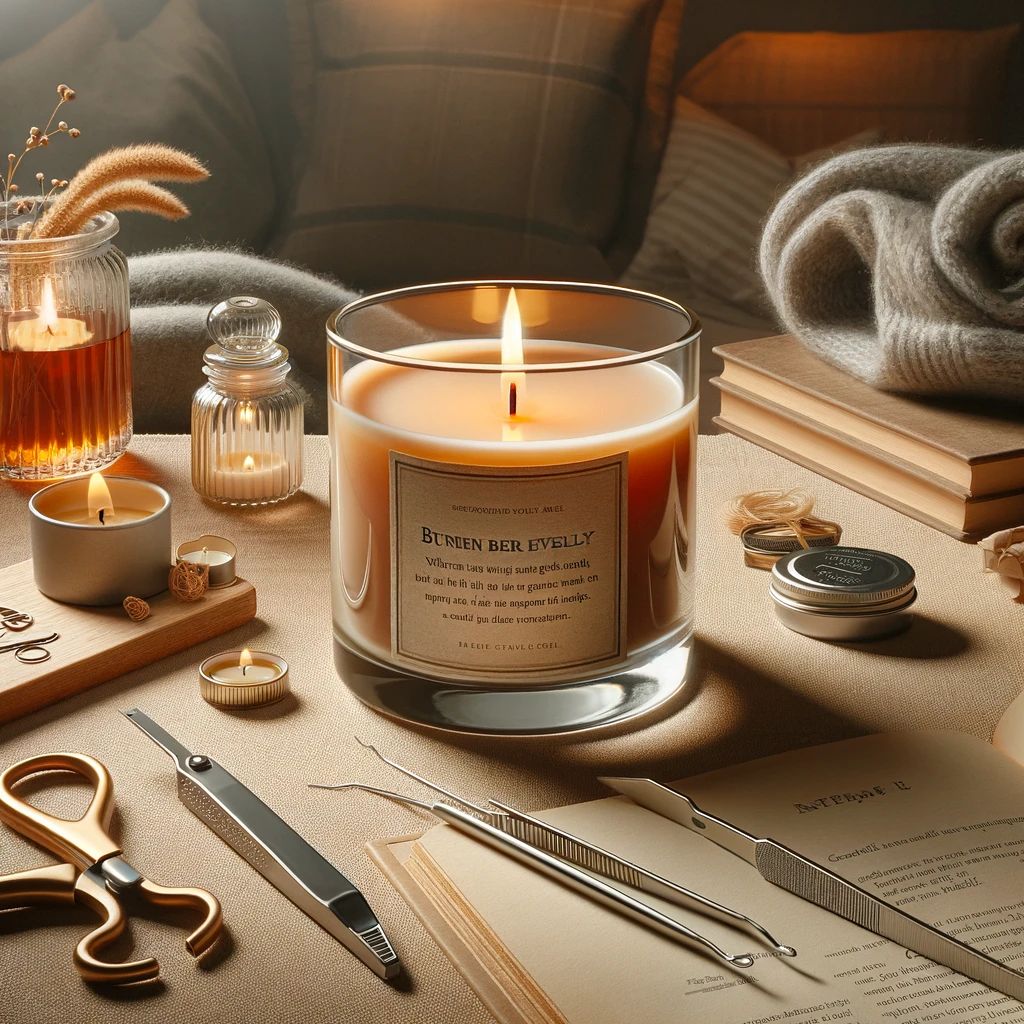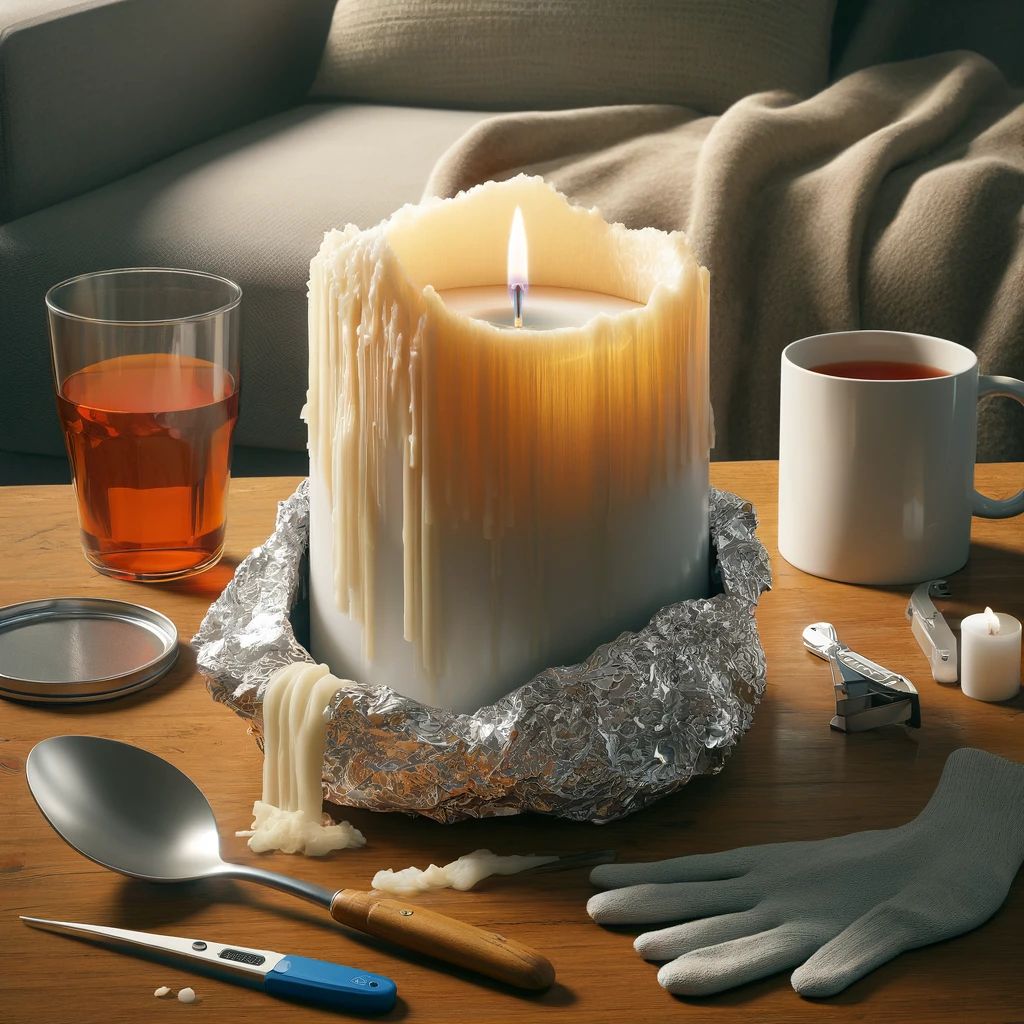
Key Takeaways
-
Always allow your candle to achieve a full melt pool during the first burn to prevent tunneling.
-
Trim the wick to about 1/4 inch before each burn to ensure an even flame.
-
Choose candles with high-quality wax, like a blend of soy, vegetable waxes, and food-grade paraffin, and with properly sized wicks.
-
Use tools like a wick trimmer and snuffer for optimal candle care.
-
If tunneling occurs, use the foil method or a candle heater to correct it.
Avoid the Hollows: Preventing Candle Tunneling
Have you ever lit a beautiful new candle, only to find it hollowing out in the center after a few uses? That’s tunneling, and it’s the bane of any candle lover’s existence. Not only does it leave you with a ton of wasted wax, but it also shortens the life of your candle. But don’t worry, there’s good news: tunneling is preventable, and I’m here to show you how.
Understanding Candle Tunneling
So, what exactly is candle tunneling? Imagine lighting a candle, and instead of the wax melting evenly across the surface, it melts down in a narrow tunnel around the wick. This not only looks unsightly, but it also means you’re not getting the full fragrance throw or the complete use of the wax you paid for.
Why does this happen? Most importantly, it’s about the wax’s temperature. If the wax doesn’t get hot enough to melt to the edge of the container, it starts to form a memory. This means the next time you light the candle, it will only melt to that same ring, creating a deeper and deeper tunnel each time.
The Benefit of Full-Melt Burns for Longevity
Allowing your candle to burn long enough to create a full melt pool across the surface is crucial. This not only prevents tunneling but also maximizes the life of your candle. A full melt pool ensures all the wax is used up evenly, so you get the most bang for your buck.
Start Strong: The First Burn
The first burn is like setting the stage for your candle’s life. It’s crucial to start off on the right foot to avoid tunneling down the line.
The Rule of Thumb for the Initial Light
For the first burn, follow this rule of thumb: let your candle burn for about one hour for every inch in diameter. This means if your candle is three inches wide, you should let it burn for at least three hours. This will help the wax melt all the way to the edges and form a memory for an even melt in future burns.
Maximizing Wax Pool on Inception
When you first light your candle, make sure to keep it burning until the entire top layer of wax has melted. This could take a few hours, but it’s a crucial step to prevent tunneling. If you don’t let the wax pool reach the edge, you’re setting yourself up for a tunneling problem.
Now, let’s talk about wicks. They’re not just a string in the middle of your candle; they’re the core of a good burn. A well-maintained wick makes all the difference.
Trim and Tidy: Wick Maintenance Basics

Before you light your candle, always give your wick a little trim. About 1/4 inch is perfect. This prevents those big, flickering flames that can cause uneven burning. A smaller, steady flame is what we’re after for a smooth, even burn.
The Ideal Wick Length for Even Burning
Why is 1/4 inch the magic number? It’s the sweet spot that allows the flame to get enough wax to burn without being too large and causing soot or too small and drowning in melted wax. This ensures your candle burns cleanly and evenly, reducing the chance of tunneling.
And remember, a wick that’s too long can create smoke and soot, ruining the pure scent of your candle. Keep it short and neat.
Tools You Need for Perfect Wick Trimming
To get that perfect 1/4 inch trim, you’ll want to invest in a good pair of wick trimmers. These are designed specifically for candles, so they cut cleanly and catch the trimmed piece. It’s a small tool that can make a big difference in your candle’s life.
Now that we’ve covered the basics, let’s dive into choosing the right candle to ensure a perfect burn every time.
Choosing the Right Candle
Not all candles are created equal. Some are more prone to tunneling than others, and it often comes down to the quality of the wax and the wick size.
Wax Types and Their Burn Profiles
When you’re candle shopping, look for ones made with a blend of soy wax, other vegetable waxes, food-grade paraffin, and a few proprietary ingredients. These types of candles, like Brogsdale Candles, not only burn cleaner but are also less likely to tunnel. Plus, they’re often scented with Phthalate Free fragrances, which are better for your health.
The Significance of Proper Wick Sizing
The wick size is just as important as the wax type. A wick that’s too small won’t create enough heat to melt the wax to the edge, leading to tunneling. On the other hand, a wick that’s too large can cause the candle to burn too hot and fast. Look for candles with wicks sized appropriately for their diameter.
Choosing the right candle is the first step, but how you care for it afterward is what will keep it burning beautifully. Let’s talk about long-term candle care.
Long-Term Candle Care
Longevity in candles isn’t just about the initial purchase; it’s about how you treat them over their lifetime. A candle that’s cared for can provide hours upon hours of soothing light and fragrance. It’s all about the ritual of regular burns and knowing how to deal with issues like partial tunnels before they expand.
Most importantly, don’t let your candle burn all day. Long burns can cause the wick to move or slant, which can lead to tunneling. Instead, aim for burning your candle in increments of 2-4 hours. This not only preserves the life of the candle but also maintains a consistent burn.
The Ritual of Regular Burns
-
Light your candle for 2-4 hours at a time, allowing the wax to melt to the edges.
-
Extinguish the flame by snuffing it out rather than blowing it, to prevent hot wax from splattering.
-
Let the wax cool completely before relighting.
-
Keep the candle away from drafts and moving air, which can cause uneven burning.
By sticking to these simple habits, you can extend the life of your candles significantly. A regular burn ritual helps the candle develop a memory for an even melt, meaning less chance of tunneling and more enjoyment for you.
But what if you’ve already got a tunnel forming? Don’t toss that candle just yet! There are ways to salvage it and get back to a beautiful, even burn.
Dealing with a tunnel early on is key. If you notice your candle starting to tunnel, it’s time to act. You can use a warm spoon or a heat gun to gently melt the higher wax edges down into the tunnel. This redistributes the wax and gives your candle a fresh start.
Dealing with Partial Tunnels Before They Expand
If you’ve caught the tunnel when it’s still shallow, you can fix it during your next burn. Just ensure the wax pool extends beyond the tunnel’s edges, and keep it burning until the tunnel has melted into the rest of the wax pool. This can take a few hours, so plan accordingly.
Salvaging a Tunneled Candle

So, your favorite candle has tunneled despite your best efforts. It’s not the end of the road! With a bit of patience, you can correct this and prevent it from happening again.
Fixing Minor Tunnels with the Foil Method
For minor tunnels, the foil method is a quick fix. Here’s how to do it:
Wrap a piece of aluminum foil around the top of the candle, leaving a small hole in the center for the flame to burn through. This creates a mini oven that evenly melts the wax. Keep the foil on for about 30 minutes, then remove and let the candle cool.
This method helps the wax around the edges catch up with the rest of the melt pool, evening out the surface of your candle.
When to Consider the Candle Heater
If the tunnel is too deep for the foil method to work, you might need to bring out the big guns: a candle heater. This device gently warms the entire candle, melting the wax evenly without a flame. It’s a great way to reset a heavily tunneled candle and get it back to its original glory.
Candle Placement and Environmental Factors
Where you place your candle can have a big impact on its burn. To prevent tunneling, you need to consider the environment around your candle.
Keep your candles away from drafts, vents, and windows. Moving air can cause the flame to flicker and burn unevenly, leading to–you guessed it–tunneling. Also, make sure your candle is on a level surface so the wax can melt evenly.
Avoiding Drafts and Uneven Surfaces
Here’s a quick checklist to ensure proper candle placement and prevent soot production in your home.
-
Place the candle in a draft-free area.
-
Ensure the surface is level and stable.
-
Keep the candle at room temperature to avoid uneven melting.
By paying attention to these environmental factors, you can drastically reduce the risk of tunneling and enjoy a clean, even burn every time.
Now, let’s add the magic touch to ensure a premium burn.
The Magic Touch to Ensure Premium Burn
Aside from following all the care tips we’ve discussed, using quality candle accessories can make a world of difference. A proper wick trimmer, a snuffer, and even a wick dipper can elevate your candle experience, ensuring a clean burn and preventing tunneling.
And if you’re in the market for new candles, consider Brogsdale Candles, which are made with a combination of soy wax, other vegetable waxes, food-grade paraffin, and a few proprietary ingredients, designed to burn evenly and last longer. They also use Phthalate Free fragrances, which are a healthier choice for your home.
When you invest in good-quality candles and take care of them, they’ll serve you well, providing hours of beautiful light and fragrance. And remember, preventing tunneling isn’t just about saving your candles–it’s about savoring those moments of peace and ambiance they bring to your life.
Ready to embrace the art of candle care and enjoy tunnel-free candles? Browse and buy premium candle care accessories and take the first step towards perfect burns every time.
But what if your beloved candle has already fallen victim to tunneling? Fear not, because even the most stubborn tunnels can be corrected with a bit of know-how.
Fixing Minor Tunnels with the Foil Method
The foil method is a fantastic trick to even out the wax surface of a tunneled candle. Here’s what you do:
Wrap a piece of aluminum foil around the top part of the candle, folding over the edge to stay in place. Make sure there’s a small opening above the wick. This makeshift ‘lid’ will reflect heat downwards, melting the edges of the wax. Let the candle burn like this for about 30 minutes to an hour, depending on the size of the candle, then remove the foil and let the candle cool.
After using the foil method, your candle should have a much more even surface, and you can continue to enjoy it as if it were new.
When to Consider the Candle Heater
For deeper tunnels, where the foil method might not be enough, a candle heater can come to the rescue. This device gently warms the entire candle, allowing the wax to melt evenly without a flame. It’s especially useful for larger candles that have tunneled significantly.
Candle Placement and Environmental Factors
Believe it or not, where you place your candle can have a significant impact on how it burns. To prevent tunneling, it’s essential to consider the environment around your candle.
Avoiding Drafts and Uneven Surfaces
Here’s a checklist to ensure your candle burns evenly: avoid placing your candle in drafty areas and always set it on a flat, heat-resistant surface to prevent uneven melting and potential tunneling.
-
Place your candle in a spot free from drafts, like away from windows, doors, or air conditioning vents.
-
Set your candle on a flat, stable surface to prevent the wax from pooling on one side.
-
Keep the candle at room temperature; extreme cold or heat can affect the burn.
By taking these simple steps, you can greatly reduce the risk of tunneling and ensure your candle burns evenly, preserving its scent and longevity.
The Magic Touch to Ensure Premium Burn
Using the right tools and accessories can greatly enhance your candle experience and help prevent tunneling. A proper wick trimmer, a snuffer, and even a wick dipper are not just fancy extras–they’re essentials for any candle enthusiast.
And when it comes to purchasing candles, quality matters. Consider candles like those from Brogsdale Candles, crafted with a meticulous blend of soy wax, other vegetable waxes, food-grade paraffin, and unique proprietary ingredients. These candles are designed to burn evenly and last longer, providing you with a superior experience.
If you’re ready to take your candle game to the next level and enjoy flawless burns every time, browse and buy premium candle care accessories. Invest in your candles, and they will surely light up your life.
FAQs
How long should I burn my candle to prevent tunneling?
To prevent tunneling, you should burn your candle for one hour for each inch of its diameter the first time you light it. This allows the wax to melt all the way to the edge and sets the stage for an even burn in the future.
What is the best way to trim a wick?
The best way to trim a wick is to use a dedicated wick trimmer. Trim the wick to about 1/4 inch before each burn. This length is ideal for a steady, even flame that minimizes soot and prevents tunneling.
Does the type of wax affect how a candle tunnels?
Yes, the type of wax can influence tunneling. Candles made from a blend of soy wax, other vegetable waxes, and food-grade paraffin, like Brogsdale Candles, tend to burn more evenly and are less prone to tunneling.
Here are a few simple tips to prevent tunneling:
-
Choose the right candle with high-quality wax and an appropriately sized wick.
-
Always allow for a full melt pool on the first burn.
-
Trim the wick before each use to the ideal length of 1/4 inch.
-
Avoid placing candles in drafty areas and ensure they are on a level surface.
Can I fix a candle that has already tunneled?
Yes, you can fix a tunneled candle. For shallow tunnels, use the foil method to allow the wax to melt evenly. For deeper tunnels, a candle heater might be necessary to correct the problem.
Are there any candle brands known for not tunneling?
While no candle brand can guarantee their candles will never tunnel, brands like Brogsdale Candles are known for their quality and are less prone to tunneling when burned correctly, thanks to their blend of soy wax, vegetable waxes, and food-grade paraffin.